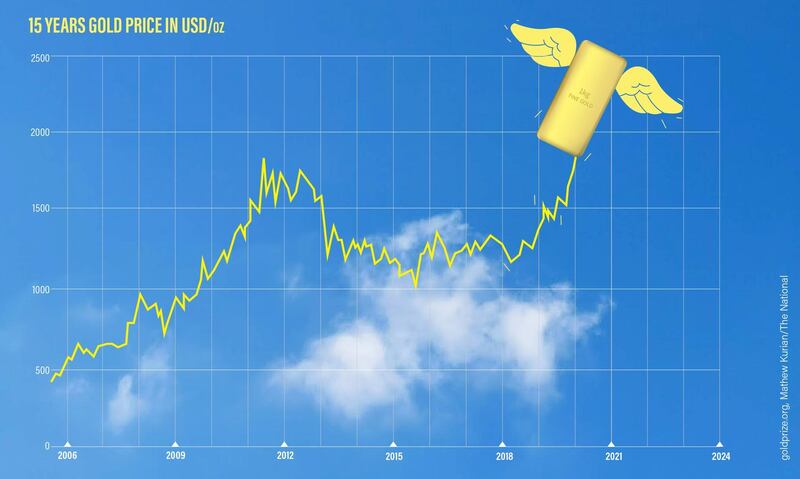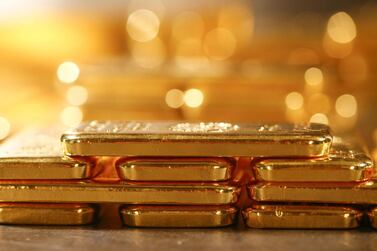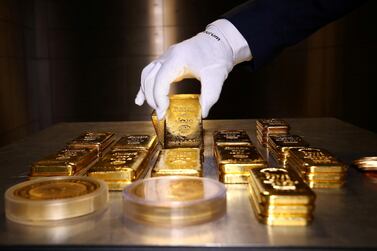In a troubled year for investors, the gold price has dazzled, flying to an all-time record high of just under $2,000 at the time of writing.
The precious metal’s success is no flash in the pan. It has risen more than 600 per cent in the past 20 years, according to Goldprice.org. Frankly, it deserves a medal.
Gold could continue to shine as Covid-19 uncertainty drags on. In April, Bank of America forecast it would hit $3,000 in the next 18 months, which, if correct, means it could still rise another 50 per cent from here.
As the stock market rally fizzles out, bond yields fall and interest rates on cash heads into negative territory, investors will need little encouragement to pile into gold.
You should approach with caution though. The higher the gold price climbs, the further it could fall. There is a danger that today’s investors are jumping onto the bandwagon too late.
The gold price fell last week, and Fawad Razaqzada, market analyst at ThinkMarkets, says both gold and silver prices look “extremely overbought”. “Profit-taking near key levels sparked the sharp sell-off,” he says.
Chris Beauchamp, chief market analyst at online trading platform IG, says this shows there is no such thing as a one-way trade, but gold should still grow. “Plenty of traders will be looking to hop onto the summer’s most exciting investment," Mr Beauchamp says.
Gold has been a store of value for more than 4,000 years. Interest waned during the stock market bull runs of the 1980s and 1990s, but has recovered strongly in our troubled millennium. The dot-com crash, 9/11 terror attacks, Iraq war, 2008-09 financial crisis, eurozone crisis and now Covid-19 have conspired to drive the price ever higher.
Carsten Menke, head of next generation research at private bank Julius Baer, says everything is falling into place for gold right now.
Like all commodities, gold is priced in US dollars. As the dollar has weakened with the pandemic hitting the US economy, gold has become relatively cheaper to non-dollar buyers and further fuelled demand.
“The weaker US dollar is pushing bond yields deeper into negative territory. US coronavirus cases are spiralling out of control, while tensions are rising with China,” he says.
Mr Menke says while its momentum could continue, today’s “lofty” price is no longer justified. “An improving economic environment should eventually weigh on demand, leading prices somewhat lower.”
Some investors may be tempted to invest in silver after the price has jumped 30 per cent in recent weeks, but again, Mr Menke urges caution. “Should the market mood get even more bullish, a speculative bubble could develop as it did a couple of years ago.”
Maurice Gravier, chief investment officer at Emirates NBD, says the bank is overweight on gold, and recommends its clients have between 5 and 6 per cent of their portfolio in the precious metal. “We were even more overweight, but took partial profits in July,” he says.
One of the attractions of gold is that it behaves differently to stock markets, typically rising when they fall and vice versa.
Mr Gravier says gold offers investors “priceless” diversification and is a valuable store of wealth. “Gold is the currency nobody can print, at a time when the printing presses are running at full speed everywhere in the world.”
Central banks and governments have delivered an estimated $15 trillion (Dh55 tn) of stimulus to shield their economies from the coronavirus pandemic, according to Reuters, but the gold supply cannot be boosted the same way, supporting its long-term value.
Mr Gravier warns the metal may be a “bit too hot” at the moment, as it is trading above Emirates NBD’s fundamental year-end fair value of $1,800. “Momentum is strong and long-term perspectives are decent. So despite taking some partial profits, we remain invested and will stomach the volatility.”
Christopher Davies, chartered financial planner at The Fry Group, says gold polarises opinions more than any other asset class. “Some argue that gold produces no income and therefore you shouldn’t own it, however, this is difficult to accept in a world where interest rates are so low.”
As companies suspend dividends, bond yields fall and interest rates on cash hit record lows, the opportunity cost of holding gold is minimal.
Mr Davies says gold balances risk elsewhere in your portfolio. “Most investors are looking to achieve a more stable return and adding gold to a portfolio, alongside equities and bonds, can reduce volatility.”
The precious metal is in the unique position of being both a currency and a commodity. “In our view, it should continue to do well.”
Mr Davies says look to the long term, and be wary of piling into gold at today’s high price and unbalancing your portfolio. “It is wise to take a longer-term, strategic approach to portfolio construction.”
Demos Kyprianou, a board member of SimplyFI, a non-profit community of personal finance and investing enthusiasts in Dubai, has mixed feelings towards gold.
SimplyFI members believe the best way to save for retirement is in low-cost exchange traded funds (ETFs) investing primarily in global equities, with some bond exposure. While gold can reduce volatility, you can do without that security if you look past short-term share price volatility and simply buy and hold for the long term, Mr Kyprianou says.
It may be wise to load up on shares today while they are cheap, rather than buy gold while it is expensive.
Mr Kyprianou says gold may have a role in your portfolio once you retire and start withdrawing money to top up any pension. “At that point, you could remain 60 per cent invested in shares, 25 per cent invested in bonds and 15 per cent in gold.”
Mr Davies believes every investor should have some exposure to gold, while avoiding current hype. “We suggest a small allocation of around 5 per cent of your portfolio, to diversify and provide a more stable return,” he says.
Despite its many attractions, gold has few practical uses. The price is driven by sentiment, which can swiftly change. Gold does not always glitter.








